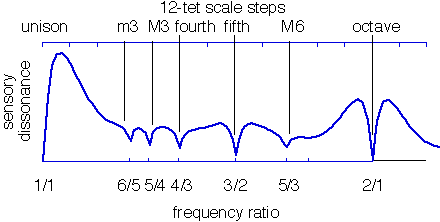Bill Sethares: Difference between revisions
Wikispaces>FREEZE No edit summary |
m external image replaced with local copy |
||
| Line 3: | Line 3: | ||
[http://sethares.engr.wisc.edu/comprog.html His dissonance measure] is based on summing the Plomp-Levelt roughness for every pair of tones in a sound, which produces smooth dissonance curves for dyads of harmonic sounds that are similar to other measures: | [http://sethares.engr.wisc.edu/comprog.html His dissonance measure] is based on summing the Plomp-Levelt roughness for every pair of tones in a sound, which produces smooth dissonance curves for dyads of harmonic sounds that are similar to other measures: | ||
[[File:Sethares-dissonance-image1.gif]] | |||
He then uses this to derive scales for timbres with non-harmonic spectra, such as the [http://en.wikipedia.org/wiki/Bonang bonang] used in gamelans, which, combined with harmonic spectra, [http://www.musicandmeaning.net/issues/showArticle.php?artID=1.3 maps to the slendro scale used to tune them] . "In the same way that Western harmonic instruments are related to Western scales, so the nonharmonic spectrum of gamelan instruments are related to the gamelan scales." | He then uses this to derive scales for timbres with non-harmonic spectra, such as the [http://en.wikipedia.org/wiki/Bonang bonang] used in gamelans, which, combined with harmonic spectra, [http://www.musicandmeaning.net/issues/showArticle.php?artID=1.3 maps to the slendro scale used to tune them] . "In the same way that Western harmonic instruments are related to Western scales, so the nonharmonic spectrum of gamelan instruments are related to the gamelan scales." | ||
Revision as of 03:26, 22 September 2018
William A. Sethares (born April 19, 1955) is an American music theorist and EE professor with extensive contributions to music theory. He is noted for work adjusting tuning and timbre based on the Plomp and Levelt approach to consonance, and work with Andrew Milne and Jim Plamondon on isomorphic keyboards, which have the same fingering in all keys and which can be seen as a generalization of the work of Bosanquet.
His dissonance measure is based on summing the Plomp-Levelt roughness for every pair of tones in a sound, which produces smooth dissonance curves for dyads of harmonic sounds that are similar to other measures:
He then uses this to derive scales for timbres with non-harmonic spectra, such as the bonang used in gamelans, which, combined with harmonic spectra, maps to the slendro scale used to tune them . "In the same way that Western harmonic instruments are related to Western scales, so the nonharmonic spectrum of gamelan instruments are related to the gamelan scales."
However, when applied to more than 2 tones, it measures major chords (4:5:6) and minor chords (10:12:15) as equally dissonant, which is not the usual interpretation. Joe Monzo explains the discrepancy by calling this measurement "roughness", not dissonance, and stating that it must be combined with "tonalness" (Paul Erlich's similarity to a harmonic series) to find the overall sonance.
